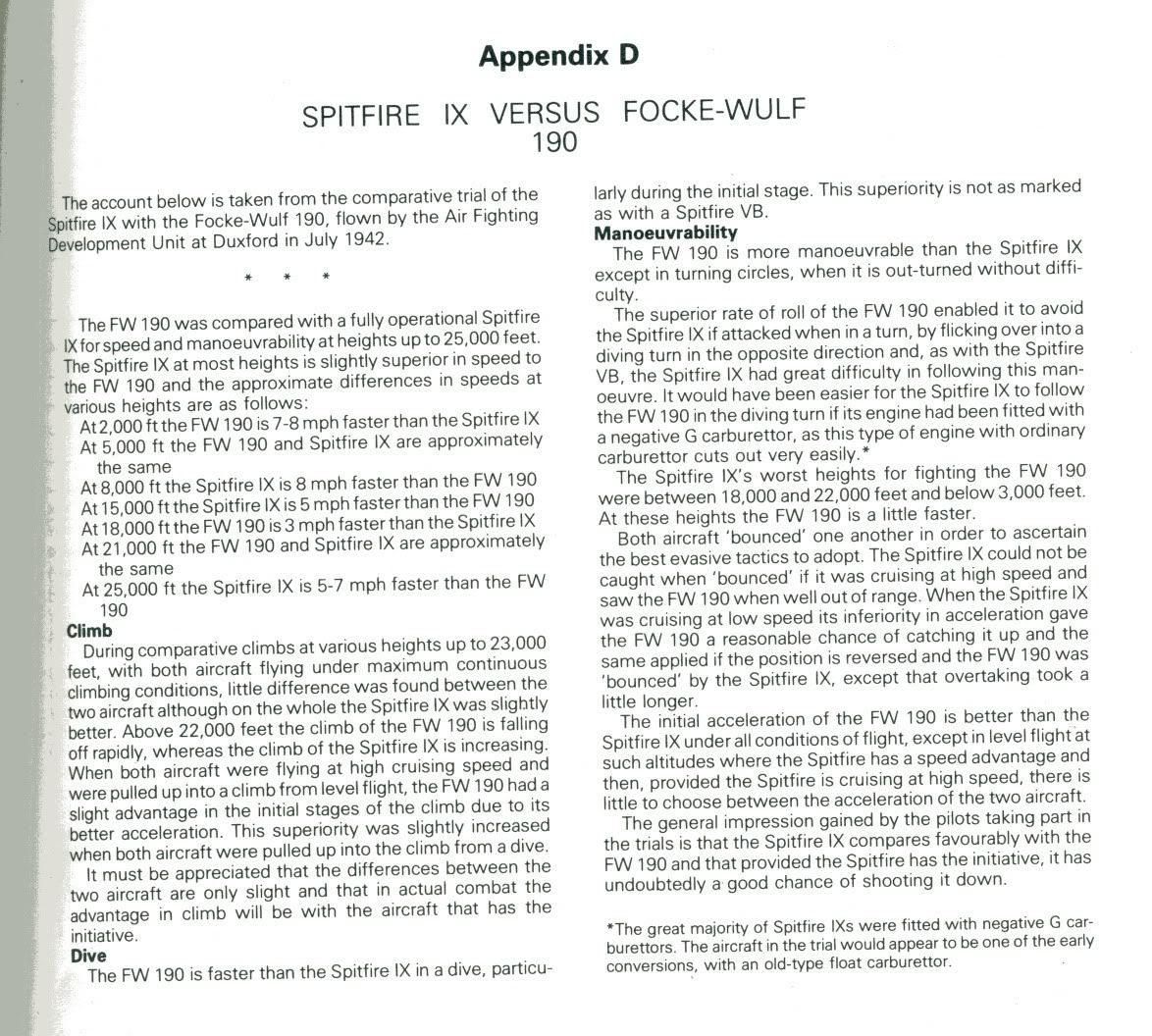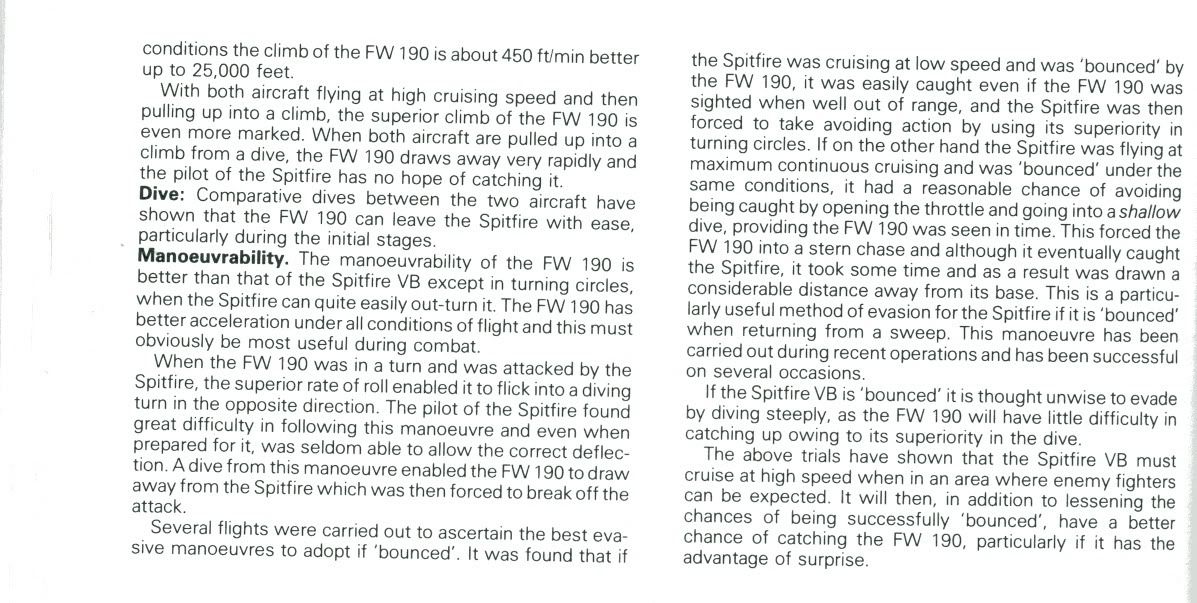
 |
|
|||||||
| IL-2 Sturmovik The famous combat flight simulator. |
| View Poll Results: do you know flugwerk company a her real one fockewulf a8? | |||
| yes |
|
2 | 33.33% |
| no |
|
4 | 66.67% |
| Voters: 6. You may not vote on this poll | |||
 |
|
|
Thread Tools | Display Modes |
|
|
|
#1
|
|||
|
|||
|
Hello guys,
I am reading the posts carefully. There are very useful infos about my favorite plane FW 190, thank you. I have a question about real FW 190 performance. How was the acceleration of FW 190 against Spitfire and P-51? Regards
__________________
AMD Phenom II X6 1100T 3.3 GHz 8 Gb RAM AMD Radeon HD 6970 VGA 64 Bit Win7 |
|
#2
|
|||
|
|||
|
I don't know for sure. It would depend a lot on the exact models in question, fuel loadouts, altitude and initial airspeed.
However: Climb rate comparison typically gives pretty good relative information about acceleration at slow speeds, because it fairly directly corresponds to thrust/weight ratio (although wing loading has some effect on it as well). If you have higher thrust/weight ratio, it means at level flight your engine provides better acceleration. As a gut feeling I would say at slow speeds the Spitfire accelerates best. The difference between a P-51B/C/D and contemporary Focke-Wulf 190 Anton would be smaller, but I would say it's likely that the P-51 would in most conditions accelerate better. FW-190 Dora has climb rate that is a close match to most contemporary Spitfires, excluding perhaps the Spitfire Mk.IX with 25 lbs manifold pressure, as well as Griffon engined Spitfires. The D-9 out-accelerates the P-51 at low speeds, and would come very close to the Spitfire's acceleration or better, I think. I have a slight impression that Spitfire (contemporary to a D-9) would still initially accelerate better, starting from low airspeed. At high speeds, things get different as the planes approach their top speeds. The FW-190 Anton had higher top speed at low to medium altitudes than most contemporary Spitfires (at least until Mark IX), so at high speeds the 190 would accelerate better simply by the virtue that it would be capable of reaching a higher top speed - the Spitfire's acceleration would end at its top speed earlier than the FW-190's. At high altitudes, the Merlin engine of Spitfire would likely outperform the FW-190's BMW engine. At high speeds, the P-51 would out-accelerate both Spitfire and FW-190 Anton, because it had the highest top speed of these planes. Or, its acceleration would continue longest, however you wish to look at it. Again, bringing the Dora into the equation mixes things a bit. I would expect it to out-accelerate the Spitfire and 190 Anton easily at high speeds and depending on altitude it might even out-accelerate the Mustang. At high altitudes, the Mustang would accelerate the longest, reaching highest top speed. At low to medium altitudes and high initial speed, the FW-190 D-9 would likely accelerate the best out of these four planes. Note: None of this is based on any flight performance data or even IL-2 Compare, just my impression and gut feeling about the capabilities of each of these planes. Dive acceleration would be another thing yet again... |
|
#3
|
|||
|
|||
|
Long ago there were questions about acceleration and climb with charts pulled out when Oleg commented that the chart was for a wide-blade prop while the IL-2 FW (just which one, I forget) models the thin-blade prop optimized for speed. Worst part, there were guys waving charts made of climb numbers for one plane matched with speed numbers from another, nuthin' but the best for the precious!
I don't recall seeing prop type in the official Aircraft Guide. Dive acceleration yes but after reading Gunther Rall in Finland I think that top speeds rule. Problem is what he was reading includes error, his P-51 did not dive any true 1400 kph. I am sure he had appreciation for how fast the ground approached so I believe when he says the P-51 and P-47 dived much faster more solidly. And that's about how it works in IL-2. Eventually 80-100 kph faster can close a lead. Last edited by MaxGunz; 12-04-2012 at 02:54 AM. Reason: dive accel |
|
#4
|
|||
|
|||
|
It's important to note that the Fw 190A was noted to have very good acceleration and to for instance out accelerate a Spitfire IX (Merlin 61) under most conditions. Imo this can be attributed to the Kommandogerät, which allowed a quicker change of power settings, so the Fw 190 was already on it's way where the Spitfire was still getting the mixture right.
|
|
#5
|
|||
|
|||
|
Quote:
Most Antons I know of can match the top level speed of most Spits and spiral climb at the same time. |
|
#6
|
|||
|
|||
|
I think the comparison with the early Spitfire IX was most probably made with an A-4.
|
|
#7
|
|||
|
|||
|
Is torque power a big difference if climb and acceleration with the Fw190A3 and Spit Vs and IXs?
(Looking at Farnborough July 1942 test) Thanks! Last edited by Faustnik; 12-04-2012 at 09:08 PM. |
|
#8
|
||||
|
||||
|
Quote:
  
Last edited by fruitbat; 12-04-2012 at 11:55 PM. |
|
#9
|
|||
|
|||
|
Quote:
|
|
#10
|
|||
|
|||
|
If it was related to prop efficiency, climb would suffer, too.
|
 |
| Thread Tools | |
| Display Modes | |
|
|